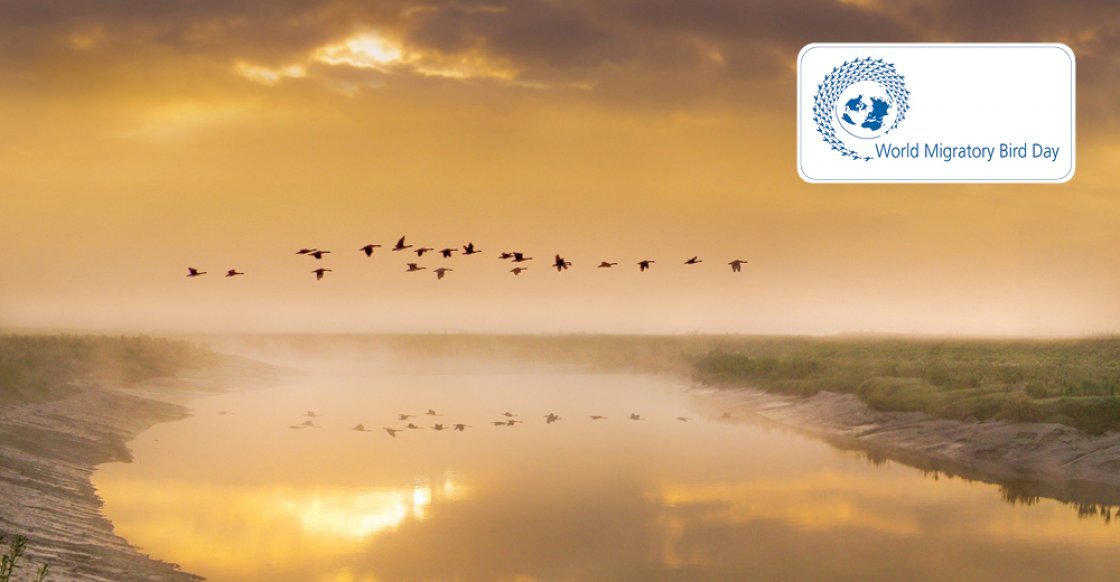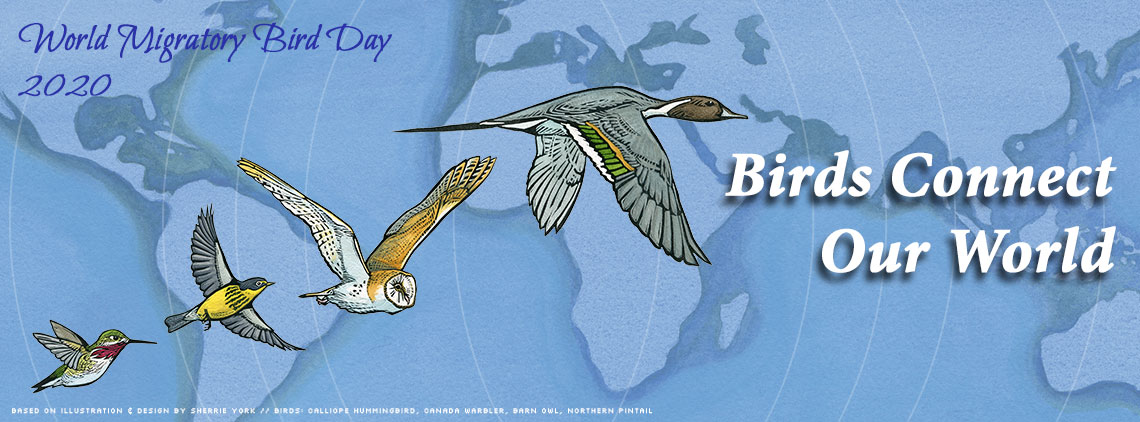You are here
World Migratory Bird Day 2020

PRESS RELEASE
World Migratory Bird Day on 10 October 2020 will celebrate the biannual migration under the theme Birds Connect Our World
Bonn, 8 October 2020 – World Migratory Bird Day will be celebrated by people across the world on Saturday, 10 October with the theme “Birds Connect Our World”.
The theme highlights the importance of conserving and restoring the ecological connectivity and integrity of ecosystems that support the natural movements of migratory birds and that are essential for their survival and well-being.
The UN-led campaign, which aims to raise awareness of migratory birds and the importance of international cooperation to conserve them, is organized by a collaborative partnership among two UN treaties - the Convention on Migratory Species (CMS) and the African-Eurasian Migratory Waterbird Agreement (AEWA) - and the Colorado-based non-profit organization, Environment for the Americas (EFTA).
On their journeys across the planet, birds face numerous threats such as habitat loss and illegal hunting as well as other threats such as poisoning, collision with power lines, wind turbines and glass-covered buildings and climate change. Migratory birds are also highly dependent on a network of sites along their migration routes for breeding, feeding, resting and overwintering.
“Migratory birds connect us to nature and they connect us to one another. Their survival depends on each of us – on each country and each person along their migration path - taking action to conserve and restore the habitats and ecosystems that they need to survive,” said Amy Fraenkel, Executive Secretary of CMS. “Conserving migratory birds requires cooperation and coordination along the entire flyway between countries and across national boundaries. Only by working together can we make sure they will survive and thrive.”
Approximately one in five of the world’s 11,000 bird species migrate, some covering enormous distances, with the Bar-tailed Godwit, for instance, flying 11,680 kilometres between Alaska and New Zealand. Migratory birds require a chain of sites and appropriate habitats, such as wetlands, coastal areas, forests and grasslands to support them during their life cycle.

“Despite the challenges that humankind must currently face, the cycles and rhythms of nature, including those of migratory birds are continuing on their normal course,” said Jacques Trouvilliez, Executive Secretary of AEWA. “But the crisis we are facing should act as a wake-up call as the roots of the pandemic can be found in the deterioration of biodiversity. We are celebrating World Migratory Bird Day only days after world leaders at the UN Summit on Biodiversity committed their countries to greater action for nature. Birds not only connect sites beyond national borders, they also connect us. Let us take into account this essential dimension of connectivity to build a healthier, more environmentally responsible and more liveable world for us all.” said Trouvilliez.
Increased global action through multilateral environment treaties such as the Convention on Migratory Species (CMS) and the African-Eurasian Waterbird Agreement (AEWA) is essential to protect migratory birds on their international journeys.
“World Migratory Bird Day is a call to action and a reminder that we are connected by birds’ journeys. Though we may be separated by miles and geography, birds connect us locally and globally,” said Susan Bonfield, Executive Director of EFTA. “Our unified voices for bird conservation bring us together in ensuring that our planet is healthy for these long-distance travellers and for us.”
Virtual events and a wave of online interactions are expected to take place in countries around the world in celebration of World Migratory Bird Day, with educational programmes being offered online by many organizations including schools, parks, zoos, forests, wildlife refuges, wetlands centres, museums and libraries.
For more information, see the global campaign website:
Also available in: French Spanish
Notes for Editors:
Events around the world
As a result of COVID 19, events marking World Migratory Bird Day 2020 are predominantly migrating indoors and online.
Virtual talks and a wave of online interactions dedicated to migratory birds are expected to take place in many countries on the day: www.worldmigratorybirdday.org/octoberevents
WEBSITE
www.worldmigratorybirdday.org
SOCIAL MEDIA
Pack: https://bit.ly/WMBD2020
@WMBD
#WorldMigratoryBirdDay
#WMBD2020
#BirdsConnectOurWorld
-------
About World Migratory Bird Day
World Migratory Bird Day is celebrated on two peak days each year (the second Saturdays of May and October) to highlight the need for international collaboration to ensure the conservation of migratory birds and their habitats globally. Registered events to mark World Migratory Bird Day 2020 will include bird festivals, education programmes, media events, quizzes, competitions and film screenings. Launched in Kenya in 2006, the UN-backed campaign has grown in popularity over the years and countries recently agreed that World Migratory Bird Day is to be celebrated globally on two peak days - to accommodate the cyclical nature of migration and to allow celebrations to take place in countries in every part of the globe. Initially created to promote the conservation of migratory birds and to counteract the negative publicity they were receiving across the world, due to concerns about their role as potential vectors of the Highly Pathogenic Avian Influenza (HPAI) virus subtype H5N1 – now commonly referred to as bird flu. Since then World Migratory Bird Day has gained in popularity with over 4,000 events organized in over 100 countries since the campaign’s inception.
The Convention on Migratory Species (CMS) and the African-Eurasian Migratory Waterbird Agreement (AEWA) — two intergovernmental wildlife treaties administered by the United Nations Environment Programme (UNEP)— organize the campaign in partnership with the Colorado-based non-profit organization, Environment for the Americas (EFTA).
About the Convention on Migratory Species (CMS)
The Convention on the Conservation of Migratory Species of Wild Animals aims to conserve terrestrial, aquatic and avian migratory species throughout their range. It is an intergovernmental treaty concerned with the conservation of wildlife and habitats on a global scale. Since the Convention's entry into force in 1979, its membership has grown steadily to include 131 Parties from Africa, Central and South America, Asia, Europe and Oceania.
www.cms.int @bonnconvention
About the African-Eurasian Migratory Waterbird Agreement (AEWA)
The Agreement on the Conservation of African-Eurasian Migratory Waterbirds (AEWA) is an intergovernmental treaty dedicated to the conservation of migratory waterbirds that migrate along the African-Eurasian Flyway. The Agreement covers 255 species of bird ecologically dependent on wetlands for at least part of their annual cycle. The treaty covers 119 Range States from Europe, Africa, the Middle East and parts of Asia and Canada. 80 countries and the European Union have become a Contracting Party to the agreement.
www.unep-aewa.org @UNEP_AEWA
Environment for the Americas (EFTA)
EFTA is a Colorado-based non-profit organization which provides bilingual educational materials and information about birds and bird conservation to raise awareness of migratory birds and to promote actions that protect migratory birds throughout the Americas.
Migratory birds matter
- Migratory birds are vital to the functioning of our planet’s ecosystems, and essential to sustaining life on Earth.
- Migratory birds bring multiple benefits to humans by providing seed dispersal, pollination, pest control and other ecosystem services and functions.
- They also provide major economic benefits and jobs, for instance, through tourism, research and education, and leisure activities such as bird watching and photography.
- Birds have played a major role in human culture. They are reflected in art, song, dance, theatre, music and religion throughout human history.
- Birds inspire us and help us connect and re-connect with nature.
Ecological connectivity is essential for migratory birds
- Ecological connectivity ensures that migratory birds can move between resting, breeding and feeding sites that support them during their life cycle.
- Over the course of more than a hundred million years migratory birds have evolved and developed complex migration strategies, adapting to climate change, annual weather cycles and specific food availability.
- Migratory birds need to be able to travel unimpeded along a network of well-functioning breeding, stop-over and wintering sites to reproduce, refuel and survive.
- The impacts of a range of human activities on the environment are affecting birds in different countries along their migration routes, so it is essential that countries work together and that conservation action is coordinated and takes place in all the countries birds pass on their journeys.
For more information please contact:
Susan Bonfield, Executive Director, Environment for the Americas, Boulder, CO, USA. Email: [email protected] | Tel: +001 970-393-1183
